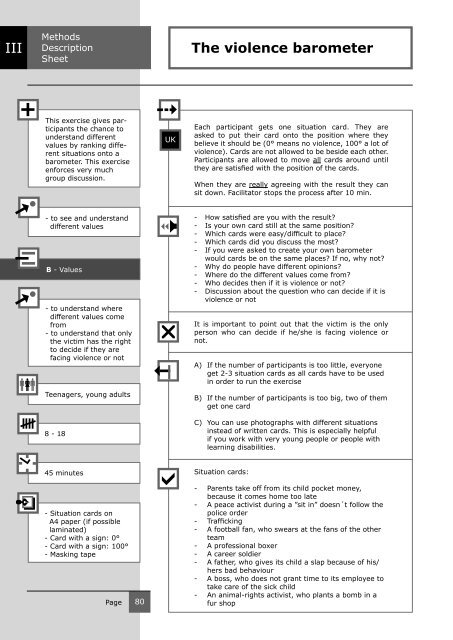Who are you? - Emergency Brake
Who are you? - Emergency Brake
Who are you? - Emergency Brake
You also want an ePaper? Increase the reach of your titles
YUMPU automatically turns print PDFs into web optimized ePapers that Google loves.
III<br />
Methods<br />
Description<br />
Sheet<br />
This exercise gives participants<br />
the chance to<br />
understand different<br />
values by ranking different<br />
situations onto a<br />
barometer. This exercise<br />
enforces very much<br />
group discussion.<br />
- to see and understand<br />
different values<br />
B - Values<br />
- to understand where<br />
different values come<br />
from<br />
- to understand that only<br />
the victim has the right<br />
to decide if they <strong>are</strong><br />
facing violence or not<br />
Teenagers, <strong>you</strong>ng adults<br />
8 - 18<br />
45 minutes<br />
- Situation cards on<br />
A4 paper (if possible<br />
laminated)<br />
- Card with a sign: 0°<br />
- Card with a sign: 100°<br />
- Masking tape<br />
Page 80<br />
UK<br />
The violence barometer<br />
Each participant gets one situation card. They <strong>are</strong><br />
asked to put their card onto the position where they<br />
believe it should be (0° means no violence, 100° a lot of<br />
violence). Cards <strong>are</strong> not allowed to be beside each other.<br />
Participants <strong>are</strong> allowed to move all cards around until<br />
they <strong>are</strong> satisfied with the position of the cards.<br />
When they <strong>are</strong> really agreeing with the result they can<br />
sit down. Facilitator stops the process after 10 min.<br />
- How satisfied <strong>are</strong> <strong>you</strong> with the result?<br />
- Is <strong>you</strong>r own card still at the same position?<br />
- Which cards were easy/difficult to place?<br />
- Which cards did <strong>you</strong> discuss the most?<br />
- If <strong>you</strong> were asked to create <strong>you</strong>r own barometer<br />
would cards be on the same places? If no, why not?<br />
- Why do people have different opinions?<br />
- Where do the different values come from?<br />
- <strong>Who</strong> decides then if it is violence or not?<br />
- Discussion about the question who can decide if it is<br />
violence or not<br />
It is important to point out that the victim is the only<br />
person who can decide if he/she is facing violence or<br />
not.<br />
A) If the number of participants is too little, everyone<br />
get 2-3 situation cards as all cards have to be used<br />
in order to run the exercise<br />
B) If the number of participants is too big, two of them<br />
get one card<br />
C) You can use photographs with different situations<br />
instead of written cards. This is especially helpful<br />
if <strong>you</strong> work with very <strong>you</strong>ng people or people with<br />
learning disabilities.<br />
Situation cards:<br />
- P<strong>are</strong>nts take off from its child pocket money,<br />
because it comes home too late<br />
- A peace activist during a ”sit in” doesn´t follow the<br />
police order<br />
- Trafficking<br />
- A football fan, who swears at the fans of the other<br />
team<br />
- A professional boxer<br />
- A c<strong>are</strong>er soldier<br />
- A father, who gives its child a slap because of his/<br />
hers bad behaviour<br />
- A boss, who does not grant time to its employee to<br />
take c<strong>are</strong> of the sick child<br />
- An animal-rights activist, who plants a bomb in a<br />
fur shop


